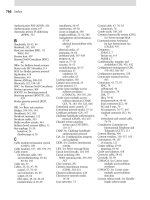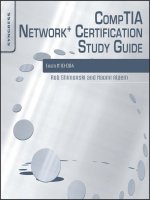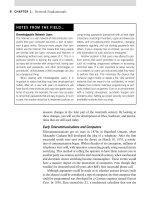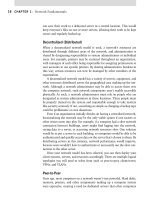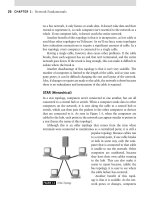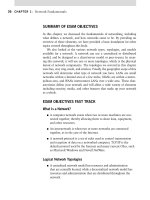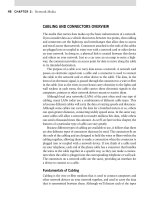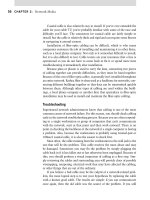CompTIA security+ certification study guide: Network security essentials
Bạn đang xem bản rút gọn của tài liệu. Xem và tải ngay bản đầy đủ của tài liệu tại đây (12.5 MB, 297 trang )
Ahmed F. Sheikh
CompTIA Security+ Certification Study
Guide
Network Security Essentials
1st ed.
Ahmed F. Sheikh
Miami, FL, USA
Any source code or other supplementary material referenced by the author
in this book is available to readers on GitHub via the book’s product page,
located at www.apress.com/9781484262337. For more detailed
information, please visit />ISBN 978-1-4842-6233-7
e-ISBN 978-1-4842-6234-4
/>© Ahmed F. Sheikh 2020
This work is subject to copyright. All rights are reserved by the Publisher,
whether the whole or part of the material is concerned, specifically the
rights of translation, reprinting, reuse of illustrations, recitation,
broadcasting, reproduction on microfilms or in any other physical way, and
transmission or information storage and retrieval, electronic adaptation,
computer software, or by similar or dissimilar methodology now known or
hereafter developed.
The use of general descriptive names, registered names, trademarks, service
marks, etc. in this publication does not imply, even in the absence of a
specific statement, that such names are exempt from the relevant protective
laws and regulations and therefore free for general use.
The publisher, the authors and the editors are safe to assume that the advice
and information in this book are believed to be true and accurate at the date
of publication. Neither the publisher nor the authors or the editors give a
warranty, expressed or implied, with respect to the material contained
herein or for any errors or omissions that may have been made. The
publisher remains neutral with regard to jurisdictional claims in published
maps and institutional affiliations.
Distributed to the book trade worldwide by Springer Science+Business
Media New York, 1 New York Plaza, New York, NY 10004. Phone 1-800SPRINGER, fax (201) 348-4505, e-mail , or
visit www.springeronline.com. Apress Media, LLC is a California LLC and
the sole member (owner) is Springer Science + Business Media Finance Inc
(SSBM Finance Inc). SSBM Finance Inc is a Delaware corporation.
This book is affectionately dedicated to all IT experts, professionals, and
students.
Table of Contents
Chapter 1: General Security Concepts and Trends
Information Security Model
Operational Model of Computer Security
Diversity of Defense
Communications Security
Access Control
Authentication
Social Engineering
Security Trends
Due Care and Due Diligence
Summary
Resources
Chapter 2: Network Fundamentals and Infrastructure Security
Network Architectures
Network Topology
Network Protocol
The OSI Model
IP Packet
TCP vs. UDP
Three-Way Handshake
Internet Control Message Protocol (ICMP)
Packet Delivery
Domain Name System (DNS)
Routing
IP Addressing
Network Address Translation (NAT)
Security Zones
Demilitarized Zone
Virtual LAN (VLAN)
Tunneling
Infrastructure Security: Securing a Workstation
Virtualization
Hubs
Bridges
Switches
Routers
Firewalls
Basic Packet Filtering
Stateful Packet Filtering
Modems
Cable Modems
DSL Modems
Virtual Private Networks
Intrusion Detection System
Mobile Devices
Media Cables
Security Concerns for Transmission Media
Object Reuse
Network-Attached Storage
Summary
Resources
Chapter 3: Wireless and Intrusion Detection System Network Security
Introduction to Wireless Networking
802.11
WAP
WAP Vulnerabilities
Bluetooth
802.11 Modulation
802.11 Individual Standards
802.11 Protocol
Attacking 802.11
NetStumbler on a Windows PC
Windows Displaying Access Points
New Security Protocols
Implementing 802.X
Types of Intrusion Detection Systems
IDS Components
NIDS Placement
Network IDS
Advantages
Disadvantages
Active vs. Passive NIDS
Signatures
IDS Matrix
IDS Detection Models
Firewall
Intrusion Prevention Systems
Proxy Servers
Types of Proxy Servers
Protocol Analyzers
Honeypots and Honeynets
Host-Based IDS (HIDS)
HIDs Advantages vs. Disadvantages
Modern HIDS
Antivirus Products
Antivirus Products: Signature-Based and Heuristic Scanning
Signature-Based Scanning
Heuristic Scanning
Personal Software Firewalls
Pop-Up Blockers and Windows Defender
Anti-spam
Summary
Chapter 4: Role of People in Security—Operational and
Organizational Security
Security Options
The Operational Process
Controls
Physical Security
Physical Barriers
Environmental Issues
Fire Suppression
Electromagnetic Eavesdropping
Location
Role of People in Security
Social Engineering
Spear Phishing and Pharming
Vishing
Shoulder Surfing
Security Hoaxes
Password Best Practices
Piggybacking
Dumpster Diving
Installing Unauthorized Hardware and Software
Physical Access by Non-employees
Security Awareness
Individual User Responsibilities
Roles and Responsibilities
Security Roles and Responsibilities
Summary
Resources
Chapter 5: Risk Management
Risk Management
Vulnerabilities
General Risk Management Model
Qualitatively Assessing Risk
Annualized Loss Expectancy (ALE)
Qualitative vs. Quantitative Risk Assessment
Management’s Response
Certification and Accreditation
Certification and Accreditation Guidelines
Certification and Accreditation Process
Approval to Operate
Approvals
Summary
Chapter 6: Change Management and Disaster Recovery
Why Change Management?
The Key Concept: Separation of Duties
Elements of Change Management
Configuration Identification
Configuration Control
Configuration Status Accounting
Configuration Auditing
Implementing Change Management
Software Change Control Workflow
The Purpose of a Change Control Board (CCB)
The Change Management Process
Management and Policy Goals
Disaster Recovery Plans (DRP)/Process
DRP Considerations
Business Continuity Plan (BCP)
What Needs to Be Backed Up?
Alternative Sites
Utilities
Secure Recovery
Cloud Computing
High Availability and Fault Tolerance
Increasing Reliability
RAID 0: No Redundancy/Improved Performance
RAID 1: Mirrored Drives/Expensive
RAID 5: Spread Across Disks with Parity/Inexpensive
Redundancy
Computer Incident Response Team (CIRT)
Test, Exercise, and Rehearse
Service-Level Agreement
Incident Response Policies and Procedures
Summary
Resources
Chapter 7: Physical Security
The Security Problem
Bootdisks
Drive Imaging
Physical Security Measures
Computer Policies
Physical Security Safeguards: Access Controls and Monitoring
Layered Access
Laptops and Mobile Devices
Closed-Circuit Television (CCTV)
Environmental Controls
Heating, Ventilating, and Air Conditioning (HVAC) Systems Are
Critical for Keeping Data Centers Cool
Fire Suppression Systems
Handheld Fire Extinguishers
Fire Detection Devices
Authentication
Access Tokens
Biometrics
Multiple-Factor Authentication
Summary
Chapter 8: Forensics, Legal Issues, and Privacy
Computer Forensics
Incident Response Cycle
Evidence
Volatility of Data
Identifying Evidence
Safeguarding Evidence
Conducting the Investigation
Steps in Chain of Custody
Understanding Drive Space Allocation
Message Digest and Hash
Analysis
Remediation After an Attack
Legal Issues
Cybercrime
Organizations Created to Fight Cybercrime
Sources of Law
Computer Trespass
Convention of Cybercrime
Electronic Communications Privacy Act (ECPA)
Computer Fraud and Abuse Act (1986)
USA Patriot Act
Gramm–Leach–Bliley Act (GLBA)
Sarbanes–Oxley Act (SOX)
Payment Card Industry Data Security Standard (PCI DSS)
Import/Export Encryption Restrictions
Encryption Rules Can Be Found in Export Administration
Regulations (EAR)
US Digital Signature Laws
Digital Millennium Copyright Act (DCMA)
Privacy
Notice, Choice, and Consent
US Privacy Laws
Privacy Policies
Privacy Impact Assessment (PIA)
Summary
Resources
Chapter 9: Attacks
Avenue of Attacks
Minimizing Possible Avenues of Attack
Attacking Computer Systems and Networks
Phishing and Pharming
Attacks on Encryption
Password Attacks
Injection Attacks
Software Exploitation
Malicious Code
Malware Defense
War-Dialing and War-Driving
Social Engineering
Scenario
Security Auditing
Summary
Resources
Chapter 10: Network Attacks
Denial-of-Service Attack
Three-Way Handshake
SYN Flood Attack
Ping of Death (POD)
Trapdoors and Backdoors
Null Sessions
Sniffing
IP Address Spoofing
Spoofing and Trusted Relationships
Spoofing and Sequence Numbers
Man-in-the-Middle Attack
Replay Attack
TCP/IP Hijacking
Drive-By Download Attack
Summary
Chapter 11: Baseline and Secure Software Development
Overview of Baselines
Operating System and Network/Operating System Hardening
Hardening Windows
Hardening Windows 2019 Server
Hardening UNIX- or Linux-Based Operating Systems
Hardening Linux: Managing User Accounts
Hardening Linux: Firewall Configuration
Hardening Mac OS X
Hardening Mac OS X: File Permissions
Updates
Network Hardening
Application Hardening
Group Policies
Security Templates
Secure Software Development
Software Engineering
Secure Development Life Cycle (SDL)
Requirements Phase
Design Phase
Coding Phase
Testing Phase
Summary
Resources
Chapter 12: Email, Instant Messaging, and Web Components
Security of Email
Hoax Emails
Spam
Mail Encryption
S/MIME
Configuration Settings in Outlook
Pretty Good Privacy (PGP)
Instant Messaging
Web Components
Current Web Components and Concerns
Buffer Overflows
Java
JavaScript
ActiveX
CGI and Server-Side Scripts
Cookies
Signed Applets
Browser Plug-ins
Open Vulnerability and Assessment Language (OVAL)
Web 2.0 and Security
Summary
Resources
Chapter 13: Authentication and Remote Access
Authentication and Remote Access
Kerberos Operations
Mutual Authentication
Domains
Models of Access Control/Discretionary Access Control
Models of Access Control Mandatory Access Control
Models of Access Control: Role-Based Access Control
Models of Access Control: Rule-Based Access Control
Remote Access Protocols
IEEE 802.1x
RADIUS
TACACS+
Secure Shell (SSH)
Virtual Private Network
Internet Protocol Security (IPsec)
Summary
Resource
Chapter 14: Access Control and Privilege Management
Privilege Management
Windows 2019 Server Users
Group Management
Password Policy Components
Domain Password Policy Elements
Single Sign-On (SSO)
Time-of-Day Restrictions
Setting Log-On Hours
Tokens
Account and Password Expiration
Security Controls and Permissions
User Rights Assignment Options from Windows Local Security
Settings
Access Control Lists
Access Control
Access Control Types
Bell–LaPadula Security Model
Biba Model
Clark–Wilson Model
Accountability
Auditing
System-Level Events
Application-Level Events
User-Level Events
Unauthorized Disclosure of Information
Internal Controls
Least Privilege
Separation of Duties
Job Rotation
Implicit Deny
Policies and Procedures
Example Policy
Acceptable Use Policy
Additional Security Policies
Human Resources Policies
Summary
Resources
Chapter 15: Cryptography
Cryptography
Common Uses of Hashing Functions
Hash Algorithms
SHA
Message Digest (MD)
Symmetric Encryption
Key Management
Trusted Platform Module (TPM)
Symmetric Algorithms
Asymmetric Encryption
Asymmetric Algorithms
Steganography
Cryptography Algorithm Use: Confidentiality
Confidentiality
Integrity
Nonrepudiation
Authentication
Key Escrow
Cryptography Algorithm Use: Digital Signatures
Cryptography Algorithm Use: Digital Rights Management
(DRM)
Cryptographic Applications
Summary
Resource
Chapter 16: Public Key Infrastructure
Public Key Infrastructure
Certificate Authorities (CA)
Registration Authorities (RA)
Steps for Obtaining a Digital Certificate
Trust and Certificate Verification
Digital Certificates
Revocation
Key Recovery
M of N Authentication
Key Escrow
Trust Models
Summary
Resource
Index
About the Author
Ahmed F. Sheikh
is a Fulbright alumnus and has earned a master’s degree in electrical
engineering from Kansas State University, USA. He is a seasoned IT expert
with a specialty in network security planning and skills in cloud computing.
Currently, he is working as IT Expert Engineer at a leading IT electrical
company.
About the Technical Reviewer
Asad Ali
is associated with High Speed Networks
Lab, National Chiao Tung University,
Taiwan, since March 2018, where he is
working on a research project funded by
the Ministry of Science and Technology,
Taiwan. In this project, he is designing a
secure and federated authentication
mechanism for multiple computing
paradigms in collaboration with multiple
partners in Bangladesh, Turkey, and the
United States. He is also working on the
cost minimization of bidirectional offloading in federated computing paradigms.
In the past, he has worked with the
Network Benchmarking Lab (NBL), Taiwan, where he designed various
security tests for IP cameras. He has various publications in the domains of
Computer Networks, Cognitive Radio Networks, PCB Routing,
Optimization, Internet of Things, and Network Security.
© Ahmed F. Sheikh 2020
A. F. Sheikh, CompTIA Security+ Certification Study Guide
/>
1. General Security Concepts and Trends
Ahmed F. Sheikh1
(1) Miami, FL, USA
In this chapter, we will review the goals of an information security program,
and you will be introduced to the information security model, a threedimensional model, which will be the foundation for learning the concepts
of confidentiality, integrity, and availability.
By the end of this chapter, you will be able to
1.
2.
Identify the concepts of confidentiality, integrity and availability.
Perform packet-level analysis.
Information Security Model
In 1991, John McCumber created a model framework for establishing and
evaluating information security (information assurance) programs, in what
is now known as The McCumber Cube . This security model is depicted
as a three-dimensional cube-like grid composed of information security
properties or desired goals, information states, and safeguards.
1. Desired Goals : The first dimension of the information security model
is made up of the three information security properties. The three
desired goals include confidentiality, integrity, and availability. Use the
acronym CIA to help remember these three principles.
Confidentiality prevents the disclosure of information for
unauthorized people, resources, and processes.
Integrity ensures that system information or processes have not been
modified.
Availability ensures that information is accessible by authorized
users when it is needed.
Chris Perrin, IT Security Consultant, provides insight on the importance
of being familiar with the industry standard term, CIA.
2.
3.
Information States : Data can be stored on a hard drive and can also
be transmitted across a network or the Internet. Data can also be
processed through manipulation by software. The second dimension of
the information security model consists of processing, storage, and
transmission.
Safeguards : Technology is usually what most information technology
(IT) professionals think of when contemplating solutions to the
information security puzzle. Policies and procedures provide the
foundation for an organization. How would you know how to configure
your firewall, a technology-based solution, without the proper policies
and procedures to guide you? Educating employees through security
awareness training program is an absolute must so that the security
measures implemented within an organization are effective.
Everything that you learn about information security can be related back
to one of the cells of this three-dimensional model.
Operational Model of Computer Security
The operational model of computer security is composed of different
technologies. Protection is the sum of prevention (like firewalls or
encryption) plus measures that are used for detection (like an intrusion
detection system, audit logs, or honeypot) and response (backup incident
response or computer forensics).
Protection = Prevention + (Detection + Response) Prevention:
Access controls, firewalls, and encryption
Detection: Audit logs, intrusion detection, and honeypot

